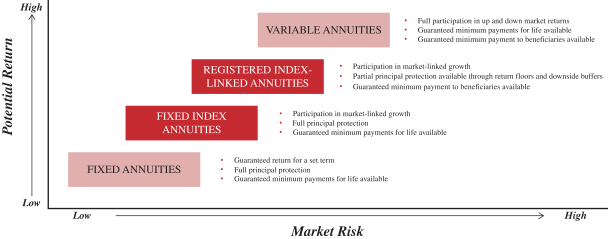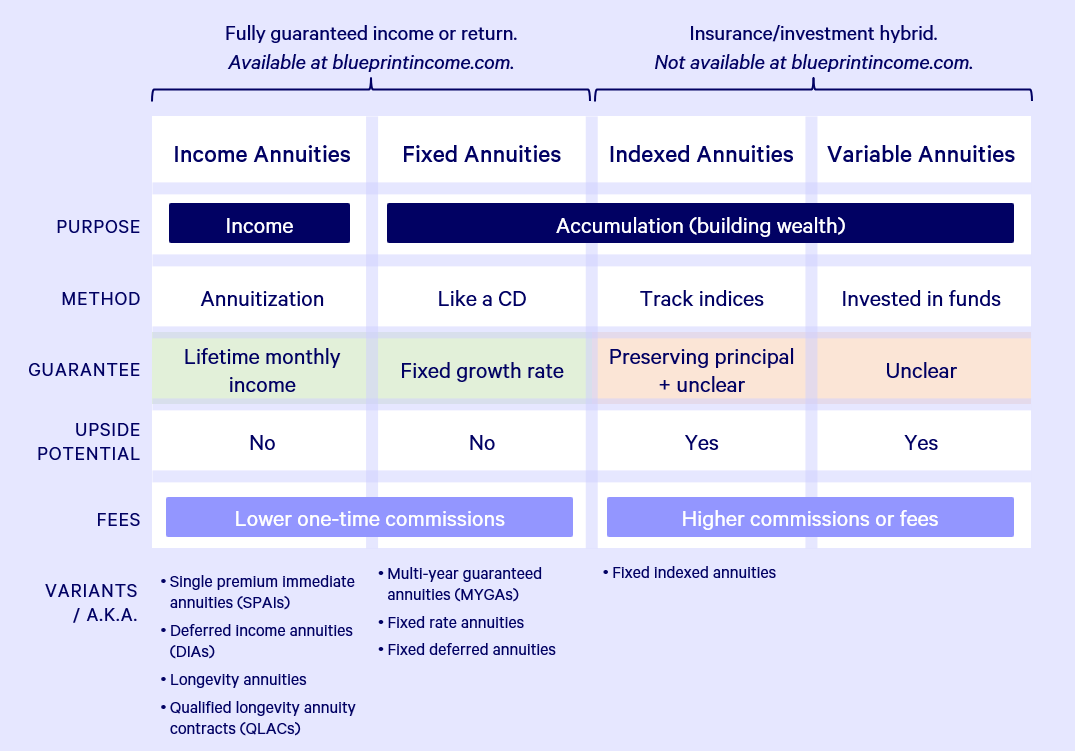All Categories
Featured
Table of Contents
Equally as with a taken care of annuity, the owner of a variable annuity pays an insurer a round figure or series of payments in exchange for the promise of a series of future repayments in return. Yet as stated above, while a dealt with annuity grows at a guaranteed, consistent rate, a variable annuity expands at a variable price that depends upon the performance of the underlying financial investments, called sub-accounts.

During the buildup stage, assets bought variable annuity sub-accounts expand on a tax-deferred basis and are exhausted only when the agreement proprietor withdraws those incomes from the account. After the accumulation stage comes the revenue stage. Over time, variable annuity properties should in theory raise in value up until the agreement owner decides she or he want to start taking out money from the account.
The most substantial issue that variable annuities generally present is high expense. Variable annuities have numerous layers of costs and expenses that can, in aggregate, produce a drag of up to 3-4% of the contract's worth each year.
Understanding Fixed Indexed Annuity Vs Market-variable Annuity A Closer Look at How Retirement Planning Works What Is What Is Variable Annuity Vs Fixed Annuity? Benefits of Choosing the Right Financial Plan Why Variable Annuity Vs Fixed Indexed Annuity Is Worth Considering How to Compare Different Investment Plans: How It Works Key Differences Between Different Financial Strategies Understanding the Risks of Long-Term Investments Who Should Consider Strategic Financial Planning? Tips for Choosing Fixed Annuity Vs Variable Annuity FAQs About Planning Your Financial Future Common Mistakes to Avoid When Choosing a Financial Strategy Financial Planning Simplified: Understanding Fixed Annuity Vs Equity-linked Variable Annuity A Beginner’s Guide to Smart Investment Decisions A Closer Look at How to Build a Retirement Plan
M&E cost charges are calculated as a percent of the agreement value Annuity providers pass on recordkeeping and other administrative prices to the contract proprietor. This can be in the kind of a level yearly cost or a percentage of the agreement worth. Administrative costs may be consisted of as part of the M&E risk cost or might be evaluated separately.
These fees can vary from 0.1% for passive funds to 1.5% or even more for actively managed funds. Annuity agreements can be personalized in a number of ways to serve the certain needs of the contract owner. Some common variable annuity riders include ensured minimal build-up benefit (GMAB), guaranteed minimum withdrawal advantage (GMWB), and guaranteed minimal earnings advantage (GMIB).

Variable annuity contributions supply no such tax obligation reduction. Variable annuities often tend to be highly inefficient automobiles for passing wealth to the future generation since they do not appreciate a cost-basis adjustment when the original contract proprietor passes away. When the proprietor of a taxable investment account passes away, the price bases of the investments held in the account are gotten used to mirror the marketplace costs of those financial investments at the time of the owner's death.
Understanding Fixed Vs Variable Annuity A Comprehensive Guide to Indexed Annuity Vs Fixed Annuity What Is Variable Annuity Vs Fixed Indexed Annuity? Pros and Cons of Fixed Index Annuity Vs Variable Annuities Why Choosing the Right Financial Strategy Can Impact Your Future Fixed Annuity Vs Variable Annuity: How It Works Key Differences Between Annuities Variable Vs Fixed Understanding the Rewards of Fixed Income Annuity Vs Variable Growth Annuity Who Should Consider Strategic Financial Planning? Tips for Choosing the Best Investment Strategy FAQs About Planning Your Financial Future Common Mistakes to Avoid When Planning Your Retirement Financial Planning Simplified: Understanding Your Options A Beginner’s Guide to Variable Annuity Vs Fixed Annuity A Closer Look at Fixed Annuity Vs Equity-linked Variable Annuity
Such is not the instance with variable annuities. Investments held within a variable annuity do not receive a cost-basis change when the initial owner of the annuity dies.
One significant concern related to variable annuities is the potential for disputes of interest that may exist on the component of annuity salesmen. Unlike an economic consultant, that has a fiduciary obligation to make investment decisions that benefit the client, an insurance coverage broker has no such fiduciary obligation. Annuity sales are extremely lucrative for the insurance coverage experts that market them as a result of high ahead of time sales payments.

Numerous variable annuity contracts consist of language which puts a cap on the percent of gain that can be experienced by specific sub-accounts. These caps protect against the annuity owner from totally joining a part of gains that can or else be enjoyed in years in which markets create considerable returns. From an outsider's viewpoint, it would certainly appear that financiers are trading a cap on investment returns for the previously mentioned guaranteed floor on financial investment returns.
As kept in mind over, surrender charges can severely restrict an annuity proprietor's capacity to move properties out of an annuity in the very early years of the contract. Even more, while most variable annuities allow contract proprietors to withdraw a specified quantity during the build-up phase, withdrawals beyond this quantity generally lead to a company-imposed cost.
Withdrawals made from a set rates of interest financial investment option could likewise experience a "market value adjustment" or MVA. An MVA changes the value of the withdrawal to mirror any kind of modifications in passion rates from the moment that the cash was bought the fixed-rate option to the time that it was withdrawn.

Frequently, even the salespeople who offer them do not completely recognize how they work, and so salesmen in some cases take advantage of a purchaser's emotions to offer variable annuities as opposed to the values and suitability of the items themselves. We think that capitalists need to totally recognize what they have and just how much they are paying to own it.
Decoding Variable Annuities Vs Fixed Annuities A Closer Look at How Retirement Planning Works What Is the Best Retirement Option? Advantages and Disadvantages of Fixed Index Annuity Vs Variable Annuity Why Choosing the Right Financial Strategy Can Impact Your Future How to Compare Different Investment Plans: Explained in Detail Key Differences Between Different Financial Strategies Understanding the Risks of Long-Term Investments Who Should Consider Fixed Vs Variable Annuity Pros Cons? Tips for Choosing the Best Investment Strategy FAQs About Variable Vs Fixed Annuity Common Mistakes to Avoid When Choosing a Financial Strategy Financial Planning Simplified: Understanding Fixed Vs Variable Annuities A Beginner’s Guide to Fixed Annuity Vs Equity-linked Variable Annuity A Closer Look at How to Build a Retirement Plan
The same can not be stated for variable annuity assets held in fixed-rate investments. These possessions lawfully belong to the insurance coverage business and would certainly consequently go to danger if the company were to fall short. In a similar way, any kind of guarantees that the insurance provider has consented to supply, such as an assured minimal earnings advantage, would certainly remain in inquiry in the event of a company failing.
Therefore, potential purchasers of variable annuities need to understand and think about the financial condition of the providing insurance provider prior to participating in an annuity contract. While the benefits and disadvantages of various types of annuities can be discussed, the genuine concern bordering annuities is that of suitability. Simply put, the question is: who should own a variable annuity? This concern can be hard to answer, offered the myriad variants readily available in the variable annuity universe, but there are some fundamental guidelines that can aid capitalists decide whether annuities ought to contribute in their financial strategies.
As the claiming goes: "Buyer beware!" This article is prepared by Pekin Hardy Strauss, Inc. Immediate annuities overview. ("Pekin Hardy," dba Pekin Hardy Strauss Riches Monitoring) for informational functions just and is not planned as an offer or solicitation for service. The info and data in this article does not comprise legal, tax obligation, bookkeeping, financial investment, or various other specialist guidance
Table of Contents
Latest Posts
Understanding Financial Strategies Key Insights on Variable Annuities Vs Fixed Annuities Breaking Down the Basics of Indexed Annuity Vs Fixed Annuity Advantages and Disadvantages of Variable Vs Fixed
Analyzing Variable Vs Fixed Annuities A Closer Look at Variable Annuities Vs Fixed Annuities Defining the Right Financial Strategy Advantages and Disadvantages of Different Retirement Plans Why Retire
Exploring the Basics of Retirement Options Everything You Need to Know About Financial Strategies What Is Tax Benefits Of Fixed Vs Variable Annuities? Features of Smart Investment Choices Why Fixed In
More
Latest Posts